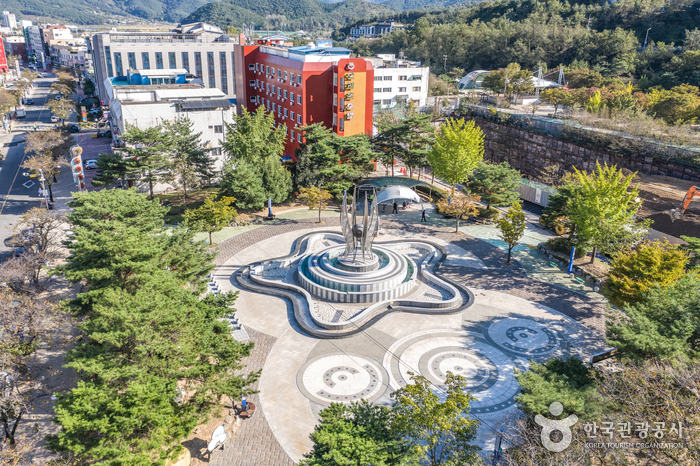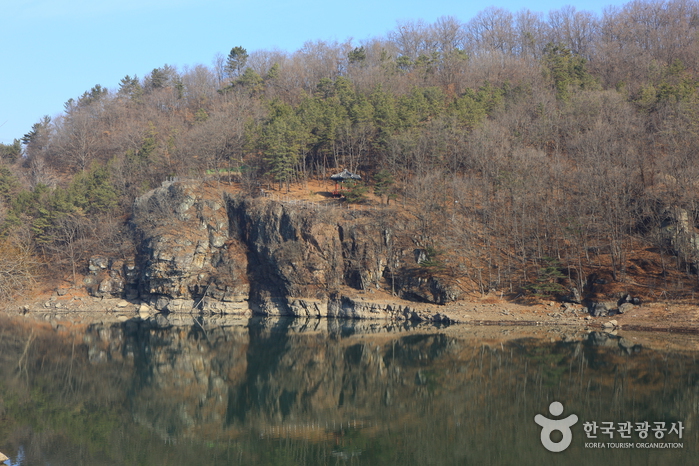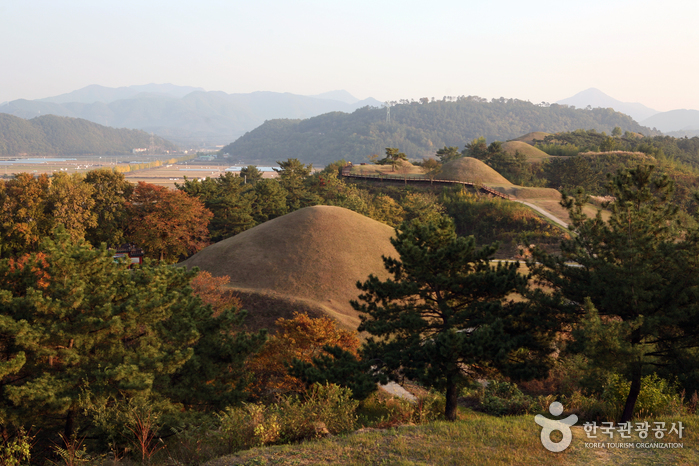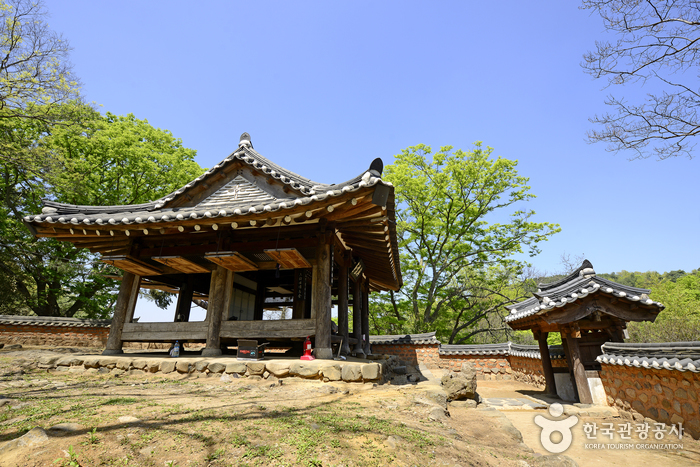Agyang Ecology Park (악양생태공원)
8.2Km 2023-10-11
208-49 Hagi 2-gil, Daesan-myeon, Haman-gun, Gyeongsangnam-do
Agyang Ecology Park is located along the Namgang River. The park is equipped with childrens play equipment, an outdoor stage, visitor's center and more. The park is a great location for people seeking to relax in nature, with many wild flowers and pink muhly growing along the pathways here.
Mannyeongyo Bridge (만년교)
9.2Km 2023-06-27
42, Wondari-gil, Changnyeong-gun, Gyeongsangnam-do
+82-55-530-1471
Mannyeongyo Bridge in Yeongsan, Changnyeong is an arch-shaped stone bridge over the village creek. Because the creek flows from the south of the mountain, the bridge is also known as Namcheongyo Bridge. Natural rocks found on the sides of the creek are used as stone flooring, and well-polished granite stones are stacked on top of the rocks in the shape of an arch. The top of the bridge is layered with round natural stones and covered with soil as a pathway for people crossing the bridge. The road surface curves and stretches on both ends, making the atmosphere of the bridge more cozy. It was first built in the 4th year of King Jeongjo of the Joseon dynasty (1780) and rebuilt in the 29th year of King Gojong (1892). It is said that the bridge is still strong enough for villagers to pass, and flood-proof. (Source: Cultural Heritage Administration)
Goryeo-dong Historic Site (고려동유적지)
12.1Km 2023-10-11
경상남도 함안군 산인면 모곡2길 53
Goryeo-dong Historic Site was founded by Yi O, a scholar of Goryeo who had unwavering loyalty to the Goryeo dynasty even after it fell. The village naturally formed by his descendants. Yi O built a stone fence around the area and called it Goryeo-donghak, meaning the home of Goryeo refugees. Yi never did serve the new government and asked his sons to also never serve the new kingdom or to move his body after he died. For over 600 years, 19 generations of Yi O have remained here, honoring his memory.
Bugok Hot Springs Special Tourist Zone (부곡온천 관광특구)
12.8Km 2024-02-27
77 Oncheonjungang-ro, Bugok-myeon, Changnyeong-gun, Gyeongsangnam-do
Bugok, named after its cast-iron pot-like terrain, boasts the hottest spring in Korea with a temperature of 78°C. It features various attractions such as Hanol Park and fountain park for performances, a refreshing trail, golf courses, and foot baths. Bugok Hot Springs is believed to be effective for arthritis, skin diseases, and fatigue recovery. Nearby attractions include Uponeup Marsh, Hwawangsan Mountain, and the Gaya Tombs.
Ipgok County Park (입곡군립공원)
13.4Km 2021-06-10
Ipgokgongwon-gil, Haman-gun, Gyeongsangnam-do
+82-55-580-4583
Ipgok County Park was once a reservoir used for agricultural water during the Japanese colonization period. Near the reservoir, a dense pine tree forest can be seen along the steep cliff and a trekking path winds through the forest. In spring, cherry blossoms provide picturesque scenery in the vicinity of the area and azaleas bloom on the ridges and cliffs as well. A sports field equipped with stands is located in the upper area.
The reservoir boasts a grand size with a 4-kilometer circumference making it the largest reservoir in Haman. However, it is shaped like a snake, making it impossible to see the starting and ending points at the same time. It is well-known as a relaxing vacation spot among local families.
Ancient Tombs in Marisan Mountain, Haman (함안 말이산 고분군)
13.9Km 2023-10-12
114 Bondong-gil, Gaya-eup, Haman-gun, Gyeongsangnam-do
The Ancient Tombs in Marisan Mountain are from the Aragaya State, and showcase the Gaya culture through many remaining relics. There are around 100 large tombs, assumed to be those of the Aragaya kings, located on the upper summit, as well as nearly 1,000 smaller tombs on the lower side of the mountain. The tombs were first excavated during the Japanese occupation, as which point Tomb No. 34 was found to be the largest tomb, with a circumference of 39.3 meters and a x_height of 9.7 meters. However, Tomb Nu. 8 is more famous, discovered to inter five people and including armor designed with images found on the tomb walls of Goguryeo kingdom.
Olive Young - Changwon Gamgye Branch [Tax Refund Shop] (올리브영 창원감계점)
14.3Km 2024-06-27
#104, and #105, 304, Gamgye-ro, Buk-myeon, Uichang-gu, Changwon-si, Gyeongsangnam-do
-
Mujinjeong Pavilion (무진정(함안))
15.1Km 2024-07-10
25 Goesan 4-gil, Haman-gun, Gyeongsangnam-do
Mujinjeong Pavilion was built atop a hill to enjoy the surrounding scenery. It was built in 1567 by the descendants of Mujin in honor of his memory. Mujin passed the government officer exam in 1483 and was promoted in 1507. The pavilion is built with three kan (space between pillars) in the front and two kan on the side, and a gabled roof. The floor is raised off the ground. There are no decorations on atop the pillars, showcasing the style during the early Joseon period.
Dalcheongyegok Valley (Changwon) (달천계곡(창원))
16.0Km 2024-02-28
145 Dalcheon-gil, Buk-myeon, Uichang-gu, Changwon-si, Gyeongsangnam-do
Dalcheongyegok Valley is a favored summer escape in Changwon, known for its clear valley waters flowing over wide rocks and dense surrounding foliage. A notable feature within the valley is a rock bearing the inscription "Dalcheon-dong" by Heo Mok, an official of the Joseon dynasty who chose this serene retreat for his retirement. During spring, the valley transforms into a renowned flower-viewing destination, adorned with the vibrant hues of azaleas in full bloom.
Ancient Tombs in Gyo-dong and Songhyeon-dong, Changnyeong (창녕 교동과 송현동 고분군)
18.1Km 2023-06-27
34, Changmil-ro, Changnyeong-gun, Gyeongsangnam-do
+82-55-530-1471
Songhyeon-dong Ancient Tombs, located under Mokmasanseong Fortress at the west foot of Hwawangsan Mountain, are large ancient tombs located in the southwest by the road leading to Hyeonpung. The Gyo-dong Ancient Tombs are dozens of ancient tombs that were once gathered around a large royal tomb, which among only eight tombs with damaged mounds now remain. Some of these ancient tombs were excavated by the Japanese between 1918 and 1919, and most of the relics were moved to Japan, and only some of them remain in Korea. According to the results of the investigation at the time, the large tombs were either built in a passageway form or an entry gate form.
It is said that a large number of relics such as jewelry made of various precious metals, including gold crowns, pure gold transplants, and copper, iron armour, and earthenware were excavated. The excavation report left by the Japanese is simple, so it is not possible to accurately grasp the structure of the Gyo-dong Ancient Tombs and the excavated relics. Twenty-one of the existing tombs have been restored so far, and only one of them has an accessible entrance.
The tombs in Songhyeon-dong are largely divided into two areas. Area 1 used to be large tombs with 80 tombs west of the foot of Mokmasan Mountain, but now only about 16 tombs remain. It is said that there were about 20 tombs in the second area near the stone Buddha in Songhyeon-dong, but now most of them have turned into rice paddies, and only a few tombs reveal their original appearance. Since the tombs are close to the Gyo-dong tombs, the structure of the tomb and the nature of the relics are believed to be almost the same. Along with the Gyo-dong tombs, a large number of relics were excavated in 1918, but the whereabouts of some of the relics are unknown.







 English
English
 한국어
한국어 日本語
日本語 中文(简体)
中文(简体) Deutsch
Deutsch Français
Français Español
Español Русский
Русский